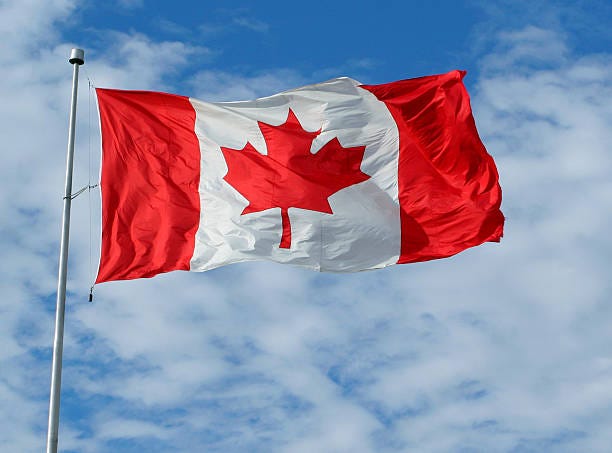Canada Should Choose the Conservatives
An Outsider's Perspective On Today's Election
From my foreign perspective, I would characterize the state of Canada as dysfunctional and underperforming. Canada’s economy has languished for a decade, dragged down by Justin Trudeau’s policies that, at best, were misguided and, at worst, deliberately harmful. Consider the energy sector: Canada holds oil reserves 10 times larger than the United States’ but produces 40 pct less crude, hampered by emissions caps and drilling restrictions which deterred investment. Oil and gas investment has halved since the Liberals took power in 2015, while Mr Trudeau’s carbon tax raised energy costs, curtailing demand for Canadian oil. When Russia’s 2022 invasion cut Europe’s energy supply, Canada failed to capitalize, unable to ramp up exports and forgoing billions in potential revenue.
The broader economy tells a similar story of stagnation. Real GDP per capita grew by just 1.1pct from 2014 to 2024, trailing the United Kingdom which grew by 6 pct, France by 7 pct, and the United States by 19 pct. Aggregate real GDP rose 17 pct, but this was driven entirely by immigration-fueled population growth, masking per capita decline. The United States, by contrast, achieved 27 pct GDP growth, with parallel gains in per capita income and productivity—areas where Canada faltered. Labor productivity in Canada crept up by 4.9 pct over the decade, hobbled by underinvestment and a shift to low-skill sectors. Immigration, which surged 227 pct from 260,000 to 850,000 annually, overwhelmed housing and infrastructure, doubling costs and pushing unemployment from 5.7 pct in 2019 to 6.4 pct in 2024. Youth unemployment, at 13.5 pct, reflects the strain.
Immigration has become a flashpoint, its second-order effects—soaring housing costs, strained services, and stagnant wages—stemming from Liberal mismanagement. To counter an ageing workforce, the Liberals relied on low-skill migrants, shifting Canada’s economy toward low-productivity sectors like retail and services. This depressed wages, squeezed out young workers, and drove productivity to a standstill. Mr Trudeau hailed immigration as creating “the world’s first post-national state”, and his ministry credited it with averting a 2023 recession. Yet this ignores the plummeting living standards: the average Canadian is poorer, with no real wage growth despite GDP increases.
Today Canadians are voting across the country, and while the Westminster model is a multi-party system, there will be one party of two who commands a majority in the House of Commons—the incumbent Liberals, led by former Bank of England and Bank of Canada governor Mark Carney or the Conservatives, led by former Shadow Finance minister and Leader of the Opposition Pierre Poilievre. Only one deserves to lead. Mr Carney’s Liberals haven’t earned it; they’ve squandered a decade on spin and profligate spending, leaving Canada as a country that is not just failing to keep pace but worse off. Had I a vote to lend, I’d back the Conservatives—or any candidate best positioned to deny the Liberals a majority—to give Mr Poilievre the chance to repair a broken economy.
Mr Poilievre is the change Canada needs, a supply-side reformer focused on productivity and efficiency—the only path to prosperity. His 15 pct income tax cut, slimmed-down state, and deregulation push would spur capital investment. To tackle housing costs, exacerbated by immigration, he pledges to scrap sales tax on new homes under C$1.3 million and cut municipal construction taxes. He also champions inter-provincial free trade, absent in Canada unlike the United States, where the Dormant Commerce Clause ensures seamless commerce. Canada’s provinces trade more with the world (66 pct) than each other (34 pct), as a result of these barriers. Mr Poilievre’s plan to dismantle trade barriers would boost efficiency, with the Conservatives planning to utilize increased tax revenues towards education and healthcare.
Energy is Mr Poilievre’s boldest pitch. His “Canada First National Energy Corridor” would fast-track pipelines, rail, and infrastructure, slashing approval times to six months and engaging the indigenous First Nations tribes to share economic gains. Repealing Bill C-69, a Liberal law that stalled projects, and scrapping the industrial carbon tax would revive oil and gas, unlocking billions in exports to Asia and insulating Canada from U.S. tariff threats. A C$1 billion investment in Ontario’s Ring of Fire would tap critical minerals, bolstering energy transition industries. Mr Carney, by contrast, advocates phasing out oil and gas, offering no clear alternative for lost revenue or jobs.
Under the Liberals, productivity and wages have stalled, despite doubled national debt and unprecedented immigration. The average Canadian has little to show for it. Mr Carney, though new to the helm, carries the Liberal mantle, offering more of the same despite polished rhetoric and patriotic ads. His C$130 billion spending plan risks further deficits—with no growth to show for it. If rejecting the status quo is the goal, only the Conservatives, under Mr Poilievre, embody anti-establishment credentials.
Polls show a tight race, with Liberals at 41 pct and Conservatives at 38 pct, buoyed by a “rally ’round the flag” effect from U.S. tariff tensions, though the Tories have seen a surge in the 11th hour. Only Mr Poilievre’s political revolution can deliver powerful paychecks, energy sovereignty, and engineer an economic renaissance. It’s time for Mr Poilievre to fix what the Liberals broke.



